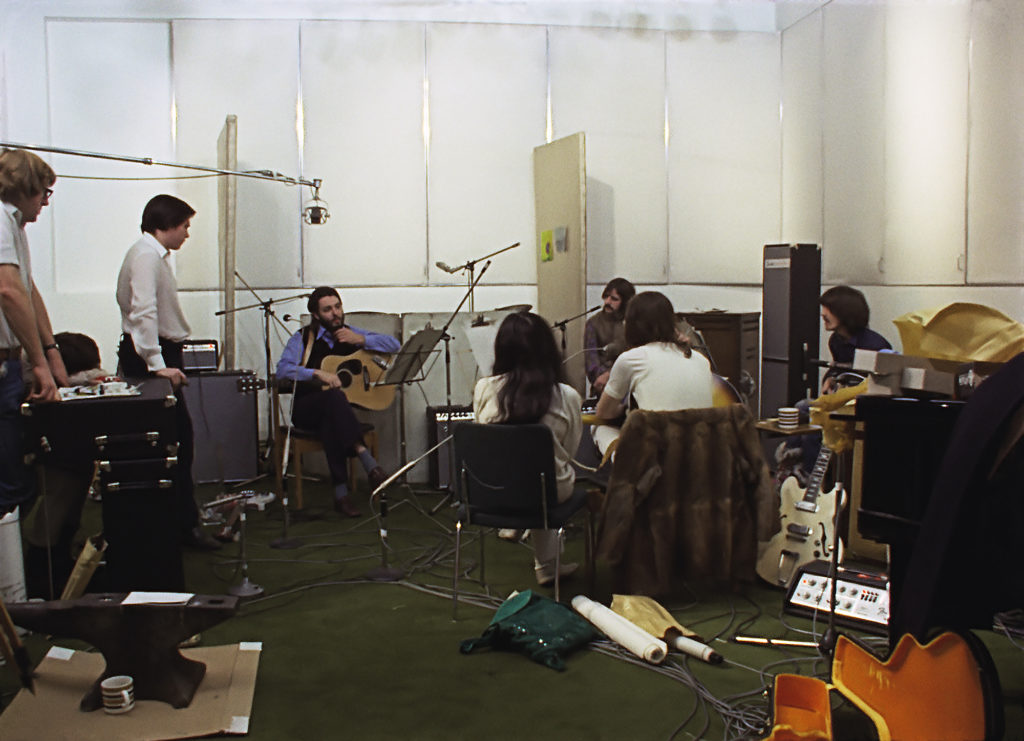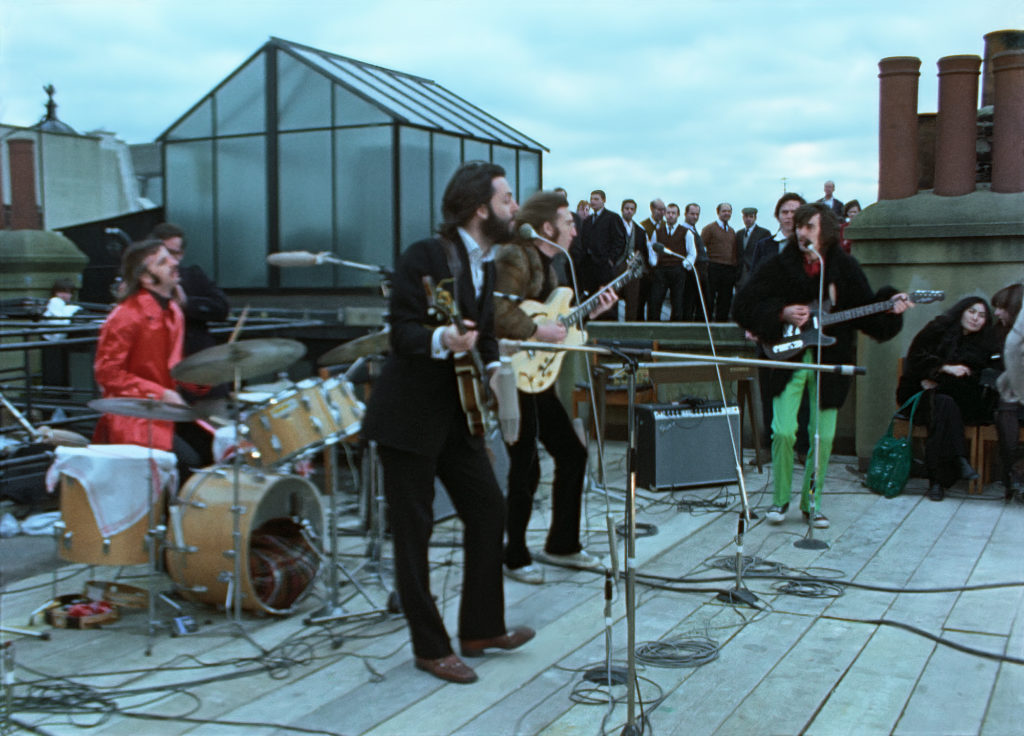The received wisdom over the last five decades was that the last album released by The Beatles was only produced after much internal strife and acrimony. The original documentary film was prime evidence, especially because the film was pulled from circulation shortly thereafter. Word began to spread a couple of years ago that the seemingly endless hours of film originally shot by Michael Lindsay-Hogg were being turned over to Peter Jackson, who would provide another perspective of how Let It Be came together.
What we now have is a six-hour opus revealing the creative process of the most influential band in history, as well as a revised look on how The Beatles worked together on the album. The film is catnip to any Beatles fan and is worth the time commitment for anyone interested in the magic of creating music.
The Beatles had two constraints in making Let It Be, both of which were important to the end result. Ringo Starr would be unavailable in four weeks (as he would be starring in The Magic Christian with Raquel Welch) and the band decided they would only perform new songs. As a result, we see the band constantly riffing and searching for the spark that would light them up.
The first of the three two-hour episodes gets off to a slow start; being tucked into the dank cavernous soundstage at Twickenham film studios in London was not conducive to the band’s creativity. The set is colorfully lit, and gives Ringo the best seat in the house on a riser slightly above his bandmates, but in close proximity to the musical genius swirling around him.
In between warm-ups that included running through songs by Bob Dylan and myriad others, The Beatles banter about where the subsequent concert should be held. The QE2 luxury liner, the Houses of Parliament and an ancient site in Tripoli are tossed aside. Everyone gamely ignores the unnatural lighting; camera technology back then required far more light.
George Harrison takes over drums, as does Paul McCartney but the musical stew cooked up by the four is endlessly tasty. Roadie Mal Evans is shown bantering with McCartney about the formation of “The Long And Winding Road” and we watch in essentially real-time as the song coalesces. It is about as close to a master class as one could find.
Despite the apparent progress on a couple of songs, the dank January setting in the mammoth soundstage is overbearing (as are the multiple layers of clothing) and The Beatles soon decamp to the basement of their Apple Corps offices on swanky Savile Row.
The often misunderstood eponymous song “Get Back” was originally intended as a satirical answer to all the anti-immigration discussion prevalent in the press, but eventually the band realizes that their ironic commentary would be misunderstood. As a result, the final version of the song was far less politically open to misinterpretation.

Throughout the six hours, we watch as imperceptibly the seemingly random components of songs come together into fully realized sonic gems. Jackson does an astounding job of cutting between John Lennon and McCartney, intercut with shots of Harrison and Starr exchanging glances as the songs begin to take shape and evolve into seemingly instant classics.
As McCartney takes over the baby grand piano and introduces “Let It Be” to the band, Jackson shows each member watching McCartney play solo, and slowly, magically each artist falls into sync. Harrison takes over bass duties, Lennon takes chord change guidance, Evans transcribes the lyrics, and engineer Glyn Johns looks on with wonder. Pure magic unfolds before our eyes. Yoko Ono and Linda McCartney whisper conspiratorially, undoubtedly sharing the awe we would experience fifty years later.
Publishing executive Dick James pays a visit early in the proceedings and chats about the value of the songwriter publishing rights. The monetary implications of these discussions is almost incalculable. This two-minute sequence among the six hours is the most insightful from the financial standpoint of the entire Beatles existence, but clearly, no one understood it at the time. Understandably, the artists only wanted to move forward in creating the music; publishing royalties were barely understood at the time.
All were not smiles and laughter during the sessions. Harrison ups and leaves, and Jackson shows the band going off the rails. Ono is given a microphone and screeches, pushing the VU needles into the red. The band seems rudderless, and various managers and executives wade into the drifting proceedings. Jackson decelerates the events via slow motion, and astutely layers in Harrison’s “Isn’t It a Pity.” The remaining three visit Harrison, but the meeting does not go well.
Further internal dynamics are revealed. McCartney observes that for Lennon “if it’s a push between the Beatles and Yoko, it will be Yoko.” With a crystal ball, McCartney points out that in 50 years it will all seem funny.
Jackson captures a fantastic sequence as a result of a hidden microphone while Lennon and McCartney have lunch and discuss Harrison’s role in the band. McCartney admits Lennon has always been the boss in the band and that they have undercut Harrison’s input.
Harrison does return, and an even keel is restored.
The band met Billy Preston during their salad days in Hamburg, the latter playing keyboards for Little Richard. Preston was in London during the filming sessions and paid a visit to the studio, unaware the band was looking for a keyboard player so they could play the new songs live without overdubs. Gobsmacked by the invitation, Preston slides behind the keyboard as if it were just another day and the sonic landscape is complete. Unmentioned in the film is that Preston would be the only artist ever credited with The Beatles on their singles.
The January days tick by on the calendar, the finished songs start to pile up and constraints force the band to consider the roof of their building as the logical site for their concert. It would prove to be their final public performance.

The film’s last hour is the apex of all the building suspense, and the payoff is thrilling. People gather on nearby roofs, crowds hold up traffic on the street below. In the swirling wind of late January 1969, the band kicks into gear. The 10,000 hours they have spent performing make it all seem so polished and effortless. “I’ve Got a Feeling,” “Dig a Pony,” “One After 909” and “Don’t Let Me Down” are assayed, leaving an indelible impression.
Like a Monty Python skit, the Bobbies arrive to shut down the concert. One fully expects John Cleese to stride in, “What’s all this about then?”
The band gamely wraps up their last live gig, and Lennon hopes they passed the audition.
Back downstairs we see the utter joy of the playback in the packed sound booth, and we see the culmination of a band in absolute full effect.
The 100 minute distilled version of Get Back recently premiered in London will undoubtedly become an appealing entry-level exposure for those coming more recently to The Beatles’ legacy.
And let’s not forget, whatever the acrimony in Get Back, they went on to record the stunning final masterpiece Abbey Road.

Leave a comment